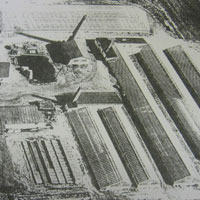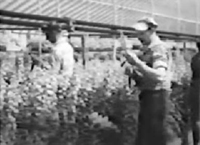The Greenbelt Native Plant Center (GNPC), a facility of the New York City Department of Parks & Recreation, is a 13–acre greenhouse, nursery, and seed bank complex located on Staten Island, NY.
Mohlenhoff Family Farm
Carl Mohlenhoff, retired Parks employee and nursery manager of the Greenbelt Native Plant Center (GNPC), began and ended his career on the same land where he was born and raised. How many New Yorkers can make that claim?

In 1911, Carl's grandfather, Henry William Dietrich Mohlenhoff, a German immigrant, moved his wife Wilhemine and their rapidly growing family from rented farmland in Middle Village, Queens to their newly acquired 32–acre plot on Staten Island. In the 1940s, sixteen of those acres, mostly wetlands, were annexed by the City to help create the William T. Davis Wildlife Refuge.
The Mohlenhoffs eventually had 12 children—each of whom survived into maturity—and the original farmhouse, now the GNPC office, was enlarged as the family grew. Everyone attended school, went to church, and attended community gatherings, but each child also worked the farm or helped in the house.
At first, the family farm grew carrots, lettuce, celery, cauliflower, and other bunching vegetables. Henry also developed a popular strain of celery and sold the seed. In the early days, the produce was taken by horse and wagon to Washington Market in lower Manhattan. In later years, it was trucked. Three to five days each week, Henry, and later eldest son Herman, would leave the farm in the late afternoon, stay in a Manhattan boarding house overnight, and bring the produce to market very early the next morning—selling right from the truck. Carl was born a bit too late to remember the horse and wagon, but remembers well his uncle Herman, who had by then become the "market man," taking off in the evenings after they had all loaded up the truck. By the 1940s, they no longer sold off the truck but rather delivered and sold to distributors.

Their four eldest sons—Herman, Henry (Carl's father), Richard, and Bernard—stayed on the farm and joined the business. As each one married and started a family of their own, they built adjoining houses on the farm property, except for Bernard who built his just up the road, since there was no room left for another house. Henry died in 1946 when Carl was 10, but Carl remembers his grandfather active in the business until the end of his life.
Carl feels remarkably lucky to have grown up in a family that not only had great respect for each other and behaved accordingly, but that also got along very well together. The entire family, all three generations, belonged to the same church, and every holiday was spent together at the main house, including those who stayed on at the farm and those who had moved away. There was harmony among the sons and their families, both in their relationships and their business dealings.
Carl speaks with a bit of glee when recalling his own childhood on the farm. After school, of course, all the children were expected to help with the farm work, but there was still time for play, and the farm was their playground. Baseball and softball was played on each field immediately after harvest, sneaking in as many games as possible before the next sowing. The children, skilled at driving the tractors of course, would create tracks on fallow fields for bicycle racing. And ball tag was always played around the farm buildings that provided shelter from getting tagged by "it."
The original farm included frontage on the Fresh Kills estuary. Carl's grandfather had developed access to the waterfront and built a pier into the water, which was used to bring barge loads of manure in for the farm. In those early years, horse carts were used all over NYC, and the manure was brought to barges in the East River to be distributed to area farms. Carl's recollections of the dock, however, were after the horses and their bounty were long gone from NYC, and he remembers a dock in some state of disrepair. The local teenagers that worked on the farm built a clubhouse, and they and the family's children used the waterfront for swimming and catching crabs. All that ended, of course, when the City created Fresh Kills Landfill in the 1950s.

After some time, the family added wholesale flower growing to their operations. Their first greenhouse was from another farm and rebuilt on the site in the mid–1930s, and within five years several more greenhouses were erected. After WWII, another greenhouse was built, and in the mid 1950s, Carl remembers going with all the men to Long Island to disassemble a standing greenhouse and then rebuilding it on the Staten Island farm. By this time, market conditions had made small scale farming in New York City difficult, and farm hands were hard to come by—the family had stopped growing produce and instead had created 42,000 square feet of heated indoor growing area for cut flowers and potted plants.
In 1950, the United Stated Army, creating a series of "educational" films about American life to be shown in occupied Japan, chose the Mohlenhoff family farm for their film about how American family businesses can be created and thrive in a free society. This was, of course, a propaganda film, but it leaves us with a very unique recording of Staten Island life at that time.
In 1956, Carl earned his degree in Horticulture, and in 1960 he was drafted and sent to Germany for over a year. But he returned to a comfortable family business, joining his father, uncles, brother, and cousins in running the nursery. Each man fell to managing one or more aspects of the business—Carl followed his father into the roles of record keeper and propagator; his brother Hank and cousin John did crop planning and production; Ben oversaw the mechanicals, plowing, and cultivating; Richard was in charge of the cut flowers; cousin Herman followed his father to become the market man. All the wives and many of the aunts worked in the greenhouses in spring, along with the children and local high school students. The bigger picture was always planned together among the men.

By 1989, after the older generations had passed on, the younger partners decided to sell the business. And in 1992, Mohlenhoff & Sons, one of the last Staten Island farm sites, was purchased by the City of New York Department of Sanitation, which was interested in creating a buffer between the landfill along the Fresh Kills estuary and communities bordering Victory Boulevard. Carl, not quite ready to retire, came to work for the Greenbelt Administrator's Office as the GNPC's Nursery Manager, after its founders, Richard Lynch and Nancy Slowick, had gone. At first, he worked at the original site of the nursery on Richmond and Travis avenues. In the meantime, the Mohlenhoff land, with its greenhouses and various other farm structures was being used as a containerized shrub nursery for the Department under the name Victory Nursery. However, the small Native Plant Center on Richmond Avenue could no longer accommodate the production of thousands of native plants for Prospect Park's restoration of the Ravine ,and in 1996, native plant operations were switched to the old farm site.
In 1998, the relocated GNPC was officially up and running, with Carl continuing as Nursery Manager. Carl's office was now in Henry and Wilhemine's original farmhouse. Carl's sister, Arlene Bartzsch, also joined the staff, helping out with greenhouse production after retiring from her career as a medical technician. She worked in the greenhouses for three years and told Carl that this was the happiest three years of her working life.
Carl, now living in Vermont with his wife Verna, is a contented man with a well–deserved and active retirement.